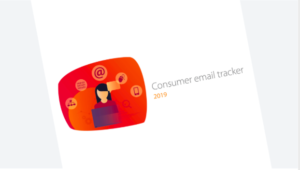
DMA Consumer Email Tracker Report 2019 – Key Findings
 The Direct Marketing Association (DMA) Email Council research hub that our founder Jenna Tiffany is a contributing member to have just released their 2019 report – and it makes for interesting reading. In an online survey of 2,022 representative respondents, they gauged attitudes and behaviours towards email marketing amongst the British public.
The Direct Marketing Association (DMA) Email Council research hub that our founder Jenna Tiffany is a contributing member to have just released their 2019 report – and it makes for interesting reading. In an online survey of 2,022 representative respondents, they gauged attitudes and behaviours towards email marketing amongst the British public.
2018 saw big shockwaves go through the email marketing landscape, with Brexit and the GDPR shaking things up and scandal-hit brands struggling to hold consumer trust. In many ways, this report is a peep above the parapet, to have a look at the state of things as the dust of 2018 settles.
And, you know what? It’s actually pretty OK. In many ways, what we’re faced with now is a lot better than what we had.
Don’t believe me? Have a read of the report and see for yourself! Here’s a summary of the key points below:
1. Email marketing still rules!
If there’s one key thing that this report reveals, it’s that email marketing remains absolutely central to brand/consumer relations. Email is the best ‘digital passport’ by which brands and consumers can reach one another – and consumers know that.
An incredible 59% of those surveyed said that they prefer to hear from brands via email. SMS is gaining traction, admittedly, but this tends to be in conjunction with rather than in opposition to email (for example, Amazon will often email an order confirmation and text a delivery time. The two work hand in hand).
2. The GDPR is a good thing
No, really! It is! This report reveals something that not enough of us suspected, but which should have been obvious had we thought about it: the GDPR makes it easier for consumers to trust brands.
41% of consumers surveyed say that the GDPR has made them a lot less wary about entrusting brands with their data. The report also notes a marked change in the way people view ‘random’ emails. Whereas before these emails would have been considered ‘unsolicited’ (and made people frustrated that their data had been sold without their consent), people now think of these emails as ‘unexpected’. The assumption is that they must, at some point, have willingly given out their email address, because the brand could not legally be emailing them otherwise. This is a big milestone in rebuilding consumer trust in brands.
3. The inbox is less crowded
Following on from our ‘GDPR is a good thing’ point, it’s worth noting that the average inbox is now a lot less crowded. Mass unsubscribes may have knocked some of us for six in 2018 – but, if you’ve managed to build up a subscriber list, you’ll find your inbox competition drastically reduced. Consumers stated that they were receiving an average of 73 emails a week in 2017, which plummeted to 51 when the GDPR rolled out.
What this means is that you’ve a much greater chance of your emails being noticed – particularly as consumers are more inclined to consider those emails which they do receive to be solicited and relevant.
4. Consumers are using their addresses tactically
![]() Just to make your segmentation more complicated, consumers are increasingly managing multiple email accounts – and using them tactically. One for work, one for emailing aunties, one for ‘important’ information, one for marketing comms… Working out how to get your emails into the account your customers check the most is going to be a challenge to crack in 2019.
Just to make your segmentation more complicated, consumers are increasingly managing multiple email accounts – and using them tactically. One for work, one for emailing aunties, one for ‘important’ information, one for marketing comms… Working out how to get your emails into the account your customers check the most is going to be a challenge to crack in 2019.
5. Everybody loves freebies
Who doesn’t like a good discount? Not many people, apparently. 75% of respondents said that they liked to be sent discounts by email. Other popular content includes e-receipts (61%), and advance notice of sales or new products (58%). I guess these fall under the equally popular headings of ‘relevant’ and ‘useful’ content…because sending an offer for an item a customer has just bought wouldn’t be a value email communication. However, it’s important to stress that just because consumers say they like discounts, that doesn’t mean we as email marketers should be constantly sending them.
6. Consumers aren’t keen on videos

Exciting videos and snappy graphics really don’t do it for the majority of consumers surveyed. I’d speculate that this is because of accessibility issues. More and more people are checking their emails via their phone (or even, increasingly, having them read out by voice tech – see my earlier article on this!). People hate it when emails suddenly start blaring out music in a quiet office, or when an unexpected vid devours their phone data.
It’s also worth noting here that 32% of the people surveyed said that they liked it when brand emails were ‘clear and concise’. So consider this for your next email marketing campaign.
7. Amazon are the email kings
According to this report, Amazon has been chosen again ais the brand whose emails consumers engage with most – garnering twice as many positive responses as the next runner-up (Ebay). However, over half of respondents either could not or would not name a brand whose emailing style they liked, so this may be a case of brand recognition trumping great content. Which leads me to….
8. Brand recognition drives opens
Consumers are far, far more likely to open an email from a brand they’re familiar with than they are from one of their lesser-known subscriptions. This is particularly the case when they are actively involved in transactions with that brand, or the brand is offering them something of great relevance. Again, this is one reason why Amazon reigns supreme in the email world – they’re usually either conveying important information about an order, or skillfully using customer data to proffer relevant products, offers, and content.
Few of us have the scope and power of Amazon, but we can build recognition through relevant content which builds a relationship with our customers. Learn what your customers find useful, and make your content reflect that.
9. Quality trumps quantity
If there’s one major thing this report highlights, it’s that quality beats quantity hands down when it comes to email marketing. For a start, 59% of respondents cited receiving too many emails as their main reason for unsubscribing. Crucially, the second most popular reason for unsubscribing is that ‘the information is no longer relevant’ (43%). So, more relevant emails, and fewer of them.
The way to ensure relevance and consumer-led quality is the same as it has always been: use the data. Data-driven tactics are nothing new, but we’re really going to have to take them seriously if we want to build a relationship with the 2019 consumer. Dig deep into your data, segment your market as closely as you can, and craft the targeted, creative content which will appeal to your customers.
10. What’s the takeaway?
We all knew that the batch’n’blast approach was dead, but this report surely has to be the final nail in its coffin. The people have spoken, and what they want is:
- More relevant emails
- Emails which are useful
- A recognition-building relationship with brands
Read the full report on the DMA website.
If you would like a review of your email marketing activity, or an expert guide you on your email marketing journey let’s talk today! Our consultants have over 10 years of experience, are elected members of the DMA UK Email Marketing Council and are recognised email marketing industry experts.

https://uk.linkedin.com/in/jennatiffany
About the Author
Jenna Tiffany is a Chartered Marketer and awarded Fellow of the IDM. She is the Founder & Strategy Director at Let’sTalk Strategy providing consultancy services across the digital marketing mix. Jenna has over ten years’ marketing experience within B2B and B2C and both client and agency side.
Industry recognised expert as an elected member of the prestigious DMA Email Marketing Council. Jenna provides marketing consultancy to brands worldwide. As a proven thought-leader, competent public speaker and publisher, Jenna can be regularly seen sharing her latest trends and key industry topics internationally.
